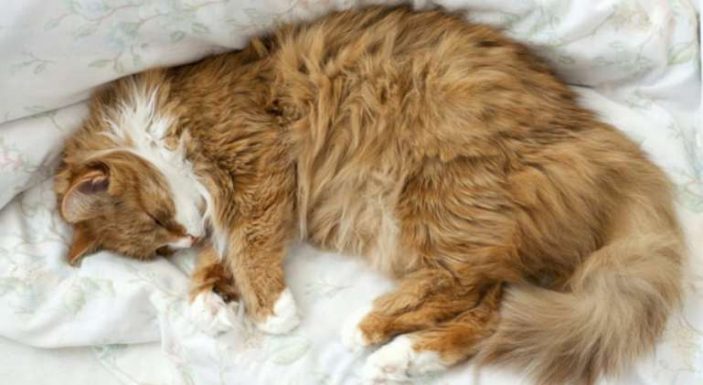Why Sleeping, it is not uncommon for human beings to dream where they may feel, see or hear something or things. Dreams are considered as hallucinations that happen during certain sleep stages especially during rapid eye movement (REM) sleep state.
While various roles of sleep are known, it is not clear why people have dreams and what functions do they have in humans. What about kitties?
We intend to look at whether these pets dream or not and concerning what things, looking it from a kitty’s perspective.
We do not intend to look at the meaning or interpretation of human dreaming of cats, i.e., whether you are seeing cats in your dreams, that could be white, black, orange, blue or big, dying, fighting, dead, and so on.
Also, we will not give you the meaning or symbolism of you dreaming about being attacked, scratched, bitten, followed by a cat or kittens and so on.

Do cats dream?
Yes. Cat, kittens, dogs and most mammals dream while slumbering. However, it occurring more in younger cats and kittens as opposed to older ones.
Sleep is very important to many brain functions and affects all body tissues. It is taught to help body systems grow and repair, help brain process whatever information and experience we went through the day, among other benefits.
Cats sleep for a much longer time than humans, about 15 hours a day and as Purina puts it, “sleep is a natural state characterized by reduced consciousness and the reduction or cessation of sensor walk, smell, and so forth.
1. Stages of sleep
There are two main stages, the non-REM and REM stages. The non-REM has three stages which upon completing them, go to the REM stage that occurs about 90 minutes after you have fallen asleep and gone through the three non-REM sleep stages.
Most of the dreaming and vivid imagery occurs during the REM stage although it can also occur during the non-REM stages.
During the REM sleep, there is rapid eye movement inside the eyelids and “mixed frequency brain wave activity becomes closer to that seen in wakefulness. Your breathing becomes faster and irregular, and your heart rate and blood pressure increase to near waking levels,” notes the National Institute of Neurological Disorders and Stroke.
There is also a temporary leg and arm muscle paralysis assumed to prevent you from acting because of your dreams and REM sleep helps in learning new information, keeping vital neural pathways, among other benefits.
2. Why do scientists think cats dream?
By studying their brain electrical activities during REM sleep, a stage where there are eye muscle twitches and comparing them to those of humans and other mammals, there is a striking similarity.
For instance, by monitoring the brain activity of awake rats while performing various activities such as running in tracts scavenging for food and their brain activity while sleeping, there was a resemblance, indicating that they do dream.
Furthermore, while talking to Metro.co.uk, Dr. Nicholas H. Dodman, a professor at the Cummings School of Veterinary Medicine in New England, USA affirms this fact by saying:
“Cats exhibit all the physiological and behavioral characteristics of dreaming sleep in humans: low voltage fast-wave activity, fast EEG (electroencephalogram) activity – where the cerebral cortex (thinking center) and hippocampus (memory center) are active in the face of continued behavioral sleep.”
Nevertheless, in cats, this is accompanied by muscle paralysis or atonia to stop responding to things you may be dreaming about.
Finally, in these things such as whisker twitching, tail twitching, stretching, paws movements, showing their claws, meowing, or whimpering may indicate that your feline is dreaming.
3. What do cats dream about?
Perhaps a more fascinating issue to tackle is what cats dream about while sleeping since unlike human beings, they do not talk.
The most common things these pets may dream about are those they experience during the day as well as in their recent or even their far past. They are only trying to process all they experienced to create a storyline.
Such things will include:
- About their owners such as being on their owners’ lap or trying to convince the owner to give them food.
- Grooming
- About altercation with other pets or animals such as fellow cats, dogs, and so on.
- Stalking a rat or bird, playing, chasing toys if they move their head during REM.
- Hunting denoted a cat acting aggressively when REM begins, i.e., “arching their backs, pouncing and hissing as they stalked around the room. They acted as if they were looking for prey,” notes Mother Nature Network.
- For young kittens, it may be about their mother, familiar smell, sights, and so forth.
Do cats have nightmares?
Nightmares are scary or frightening dreams which are more on how we may behave in case of an unrealistic event.
It is not uncommon to see your behaviors such as excessive whisker twitching, paw fisting, hissing, uncontrolled movements, looking startled or even meows. This may be an indication of a bad day or they could be having nightmares including things such as escaping from predators and so on.
Whereas a nightmare might see unpleasant, you do not have to wake up your kitty while it is having them. There is a chance you may even get scratched.
Do cats sleepwalk?
Yes, they do. However, this is due to brain damage especially if they have “ lesions around the locus coeruleus in the brainstem, notes Petful.
